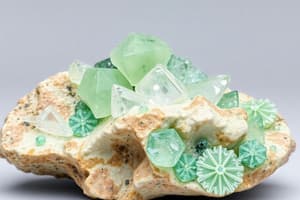Podcast
Questions and Answers
Minerals have eight physical properties that are used to identify them: color, luster, hardness, streak, density, crystal shape, __________.
Minerals have eight physical properties that are used to identify them: color, luster, hardness, streak, density, crystal shape, __________.
cleavage/fracture
What is the term for the way a mineral reflects light?
What is the term for the way a mineral reflects light?
luster
What does the term 'hardness' refer to in minerals?
What does the term 'hardness' refer to in minerals?
How a mineral resists being scratched.
What is streak in terms of minerals?
What is streak in terms of minerals?
What does density refer to in minerals?
What does density refer to in minerals?
The density of a mineral is always the same.
The density of a mineral is always the same.
You can compare the densities of similar sized minerals; the denser mineral feels heavier.
You can compare the densities of similar sized minerals; the denser mineral feels heavier.
What is the significance of crystal shape in minerals?
What is the significance of crystal shape in minerals?
What does cleavage refer to in mineral properties?
What does cleavage refer to in mineral properties?
What does fracture refer to in minerals?
What does fracture refer to in minerals?
What are considered special properties of minerals?
What are considered special properties of minerals?
How do we determine how hard a mineral is?
How do we determine how hard a mineral is?
Flashcards are hidden until you start studying
Study Notes
Properties of Minerals
- Eight physical properties are employed to identify minerals: color, luster, hardness, streak, density, crystal shape, and cleavage/fracture.
Color
- Color can be easily observed, but many minerals, like quartz, can vary in color, making it a less reliable identification factor.
Luster
- Luster describes how a mineral reflects light, which can be classified as metallic, brilliant, glassy, pearly, silky, or dull.
Hardness
- Hardness measures a mineral's resistance to scratching, a key property for identification.
Streak
- Streak refers to the color of the powder left behind when a mineral is scraped on a surface, providing another identification method.
Density
- Density is defined as the mass of matter in a specific volume, a consistent property for each mineral.
Density Consistency
- The density of a mineral remains constant regardless of size or shape.
- When comparing minerals of similar size, the denser mineral will feel heavier to the touch.
Crystal Shape
- Minerals exhibit six basic crystal shapes, each with a distinct, defined structure.
Cleavage and Fracture
- Cleavage and fracture describe the characteristics of how minerals break.
- Cleavage indicates a mineral breaks smoothly along defined surfaces.
- Fracture means a mineral breaks unevenly in jagged pieces.
Special Properties
- Special properties of minerals may include distinct smells (such as sulfur), tastes (like saltiness), fluorescence (glowing under certain conditions), and magnetism.
Moh's Hardness Scale
- Moh's Hardness Scale is a reference system used to determine the hardness of minerals, ranking them based on their resistance to scratching.
Studying That Suits You
Use AI to generate personalized quizzes and flashcards to suit your learning preferences.




